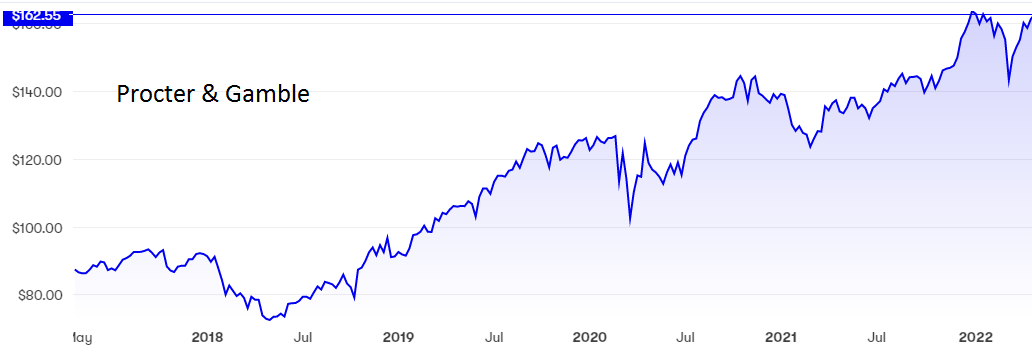A star stock to own at the right price
27th April 2022 08:34
by Rodney Hobson from interactive investor
Its shares are not far off a record high, and for good reason, but should investors buy them now? Our overseas investing expert gives his view.

Investors who switched out of highly priced tech stocks and into solid consumer staples towards the end of last year probably did right. The worry now is that the switch from cyclical to defensive stocks will come unstuck as the effects of the Ukraine war and rapidly rising prices leave consumers badly squeezed.
In that context the latest quarterly update from Procter & Gamble Co (NYSE:PG), the Cincinnati-based maker of health, hygiene and personal care items, makes instructive reading.
P&G has been significantly affected by Russia’s invasion of the Ukraine. It has two manufacturing sites plus 2,500 employees in Russia and had already reduced its operations there in early March, also halting new capital investments and all media, advertising and promotional activity in the country.
Now it concedes that it may not be able to continue even reduced operations in Russia “due to sanctions and counter-sanctions, monetary, currency or payment controls, restrictions on access to financial institutions and supply and transportation challenges". Assets there may well be confiscated and given to oligarchs supporting Russian President Vladimir Putin.
There are also two manufacturing sites and 500 employees in Ukraine. These sites could be destroyed in the conflict, but even if they survive undamaged it may be impossible to bring in supplies or distribute the products, so they too should be considered to be unusable.
- Q1 US earnings season preview
- US earnings season calendar here
- Want to buy and sell international shares? It’s easy to do. Here’s how
- How high could US interest rates really go?
Fortunately for P&G, Russia and Ukraine combined account for less than 3% of net assets and less than 2% of net earnings. Nonetheless, the impact of an invasion that is likely to drag on indefinitely will be to take 4 cents per share off earnings in the April-June quarter, the fourth in P&G’s financial year.
That is admittedly painful, but it has to be seen in the context of third-quarter figures to the end of March showing earnings per share up from $1.26 in the previous three months to $1.33, which was better than analysts had expected.

Source: interactive investor. Past performance is not a guide to future performance.
P&G has so far been able to offset its own inflationary input prices by passing higher prices on to the consumer.
Net earnings for the quarter rose 4% to $3.37 billion on net sales of products such as Ariel soap powder, Gillette razors, Head & Shoulders shampoo and Pampers nappies up 7% to $19.38 billion. All parts of the business saw increased sales, but the biggest boost came from healthcare, up 30% thanks to a greater incidence of coughs, colds and flu during the winter months.
The performance was sufficiently strong for P&G to feel able to raise its full-year guidance for the second consecutive quarter, with sales now seen as growing 4-5% against 3-4% indicated previously. Organic sales should be up 6-7% rather than 4-5%. Earnings per share should be at least 6% higher than the $5.50 recorded in 2020-21.
On the downside, higher commodity prices, rising freight costs and unfavourable forex movements will cost an additional $400 million.
I warned three months ago that rising costs would be a concern, but P&G continues to cope really well with adverse factors, and the momentum in rising sales and profits continues unabated. The share buyback programme has been stepped up to $10 billion in the current financial year, which will help to underpin the share price, and the record of raising the annual dividend for more than 60 years should continue for the foreseeable future.
- Top 10 things you need to know about investing in the US
- Find out what is now being tipped to be the best investment of 2022
- Funds Fan: recession tips, funds vs trusts, and Japan fund interview
The shares are, not surprisingly, pushing at their peak just above $160, where the yield is 2.17% and the price/earnings ratio is on the high side but not too demanding at 28.42.
Hobson’s choice: The shares look fairly valued for now so if you’re in, stay in. Otherwise, consider buying on any share price weakness should that happen. The next decisive break will surely be upwards.
Rodney Hobson is a freelance contributor and not a direct employee of interactive investor.
These articles are provided for information purposes only. Occasionally, an opinion about whether to buy or sell a specific investment may be provided by third parties. The content is not intended to be a personal recommendation to buy or sell any financial instrument or product, or to adopt any investment strategy as it is not provided based on an assessment of your investing knowledge and experience, your financial situation or your investment objectives. The value of your investments, and the income derived from them, may go down as well as up. You may not get back all the money that you invest. The investments referred to in this article may not be suitable for all investors, and if in doubt, an investor should seek advice from a qualified investment adviser.
Full performance can be found on the company or index summary page on the interactive investor website. Simply click on the company's or index name highlighted in the article.
Disclosure
We use a combination of fundamental and technical analysis in forming our view as to the valuation and prospects of an investment. Where relevant we have set out those particular matters we think are important in the above article, but further detail can be found here.
Please note that our article on this investment should not be considered to be a regular publication.
Details of all recommendations issued by ii during the previous 12-month period can be found here.
ii adheres to a strict code of conduct. Contributors may hold shares or have other interests in companies included in these portfolios, which could create a conflict of interests. Contributors intending to write about any financial instruments in which they have an interest are required to disclose such interest to ii and in the article itself. ii will at all times consider whether such interest impairs the objectivity of the recommendation.
In addition, individuals involved in the production of investment articles are subject to a personal account dealing restriction, which prevents them from placing a transaction in the specified instrument(s) for a period before and for five working days after such publication. This is to avoid personal interests conflicting with the interests of the recipients of those investment articles.